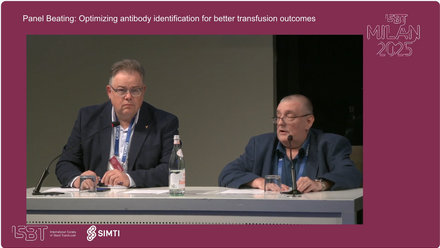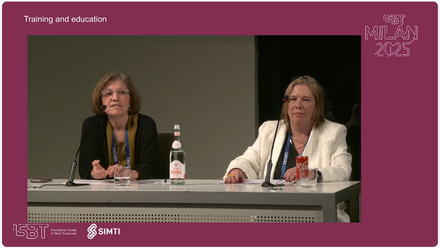The Crossmatching 2.0 session included the following presentations:
1. Christine Lomas Francis: CD47 Biotherapy: A new incompatibility threat
2. Tae-Shin Kim: The effects of IMC-002, a novel anti-CD47 monoclonal antibody, on pretransfusion compatibility testing
3. Wenhui Li: CD71+ RBCs Mediate Increased Erythrophagocytosis and Reduced Monocytes in Human Suspension Assay
4. Ling Wei: Evaluating the clinical significance of alloantibodies against GP.Mur using flow cytometry phagocytosis assay
5. Anne Cornelissen: Detection of erythrocyte alloantibodies in patient sera using a novel flow cytometry approach
MODERATORS: Sofia Lejon Crottet, Roland Fiskesund
After the presentation, there was a questions and answers session, which is also included in the recording.
Abstract
Detection of erythrocyte alloantibodies in patient sera using a novel flow cytometry approach
A Cornelissen1, K Fu2, R Millard3, T Klei4, N van der Bolt5, P Ligthart1, A Visser2,6, P Burger2, J van Dam3, C Folman1, E van der Donk6, M de Haas1, E van den Akker2
1Immunohematology Diagnostics, Sanquin Diagnostic Services, 2Hematopoiesis, 3Bioinformatics Core Facility, Sanquin Research and Landsteiner Laboratory, 4Product and Process Development, Sanquin Blood Bank, 5Experimental Immunohematology, Sanquin Research and Landsteiner Laboratory, 6Product Development, Sanquin Reagents, Amsterdam, Netherlands
Background: Accurate assessment of the presence of erythrocyte alloantibodies in a patients’ blood is crucial for ensuring matched transfusions and avoiding immune reactions against the donor product. Currently, agglutination-based assays such as manual tube-based methods and gel card systems are used to identify erythrocyte-directed antibodies. However, these methods are semi-quantitative, consume a large amount of reagents and are not multiplex compatible.
Aims: The aim of this study is to develop a novel flow cytometry test that can detect erythrocyte-reactive antibodies in serum and plasma in a single tube assay and will result in increased sensitivity and specificity of alloantibody detection. The test is designed to convert the semi-quantitative agglutination assay into a quantitative flow cytometry assay, reduce assay costs by lowering reagents consumption and make it multiplex compatible.
Methods: To detect erythrocyte antibodies present in plasma/serum, the indirect antiglobulin test was modified to be compatible with a flow cytometry readout. Using 3–4 incrementing concentrations of NHS (succinimidyl ester)-fluorescein isothiocyanate (FITC) and pacific blue (PB), reference erythrocytes are differentially labelled to identify 12 different erythrocyte populations in a single flow cytometry tube. Alloantibodies within a patient sample bind to specific implicated antigen-positive erythrocytes in the 2D flow cytometry matrix. A fluorescent secondary F(ab)-fragment recognizing human IgG is used to identify the reference erythrocytes to which the antibody has bound. We composed a test set of 500 samples including samples with anti-c, C, E, e, D, K, Jka, Jkb, M, N, Kpa, Lea, Leb, Lua Cw, Wra and some single samples with other specificities, with different titters of antibodies. The clinical background of the patients was either screening during pregnancy or expected transfusion/surgery.
Results: The 2D flow cytometry matrix has been tested for the detection of IgG antibodies within samples from patients (n = 500). The required amount of erythrocytes can be reduced by 50–100 times, and the total volume of plasma/serum needed can be limited to 10 μL in total. This represents a significant reduction in volume compared to the agglutination test. A 94% concordance to conventional agglutination techniques was observed for IgG antibodies. Non-concordant samples contained alloantibodies that could potentially be of IgM class, which was confirmed in a selection of samples by retesting using IgM specific secondary antibodies. The flow cytometry test showed an increased sensitivity in sample dilution experiments compared to the agglutination test (n = 16). Samples were diluted until they yielded negative results in the agglutination test (100–2000× dilutions). However, the flow cytometry test results for these samples remained positive. We observed that the 2D matrix can be freeze-thawed without loss of functionality. Additionally, the expiration time of the 2D matrix was found to be similar to that of conventional reference erythrocytes. Further validation is currently ongoing for samples that contain IgM antibodies.
Summary/Conclusions: We have developed a multiplex system through differential labelling of reference panel erythrocytes generating a 2D matrix that can be used for erythrocyte alloantibody specification, whereby antibody binding is detected by flow cytometry (patent pending). The flow cytometry test is fast, reduces costs due to reduced reagents requirements, generates objective readouts and can discriminate between IgG and IgM alloantibodies.





















